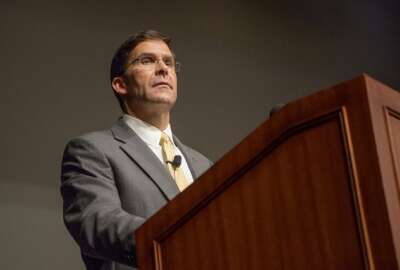OPM urging agencies to include military spouses, former inmates in hiring strategies
The Trump administration is urging agencies to focus on two often overlooked populations populations to fill federal vacancies: military spouses and formerly...
The Trump administration is urging agencies to broaden their hiring strategies and tap two often overlooked populations to fill federal vacancies.
It’s all part of a broadened goal from the administration to develop a workforce that’s more representative of the U.S. population, said Margaret Weichert, deputy director for management at the Office of Management and Budget and vice-chair of the Chief Human Capital Officers Council.
“Having people who are truly representative of all of America is very, very important,” Weichert said Monday at a public CHCO Council meeting. “Bringing people off the sidelines who may not have had as much access to federal jobs is a critically important part of what we want to do as a CHCO community.”
It’s why the Trump administration is focused on hiring military spouses and formerly incarcerated individuals.
“At a time when our labor market is very, very tight, we need every person who is willing to work to be able to come in off the sidelines and do productive work,” Weichert said. “[That means] supporting our military spouses, who, through no fault of their own — and in fact, through their service and their family’s service to their country — make it difficult to stay in one place for a very long term. We need to continue to focus on the merit they have and the diversity they bring to our workforce.”
The Defense Department estimates military spouse unemployment at 24%, well above the national average. That’s due, in part, because military families typically move every two-to-three years.
A 2018 executive order instructed agencies to step up their hiring of military spouses, mostly by using the authorities they already have to recruit them through noncompetitive appointments. The EO also requires agencies and the Office of Personnel Management to publicly report how they’re using military spouse hiring authorities.
But like most specialized hiring authorities, agencies don’t often understand exactly how to use them. To help organizations better utilize them, OPM said it’s finalizing guidance for agencies on military spouse hiring flexibilities.
A model for military spouse hiring
For the Department of Veterans Affairs, it’s taken a concerted effort — and a champion of sorts — to move the needle on military spouse hiring.
The Board of Veterans’ Appeals was the first from VA to join the Military Spouse Employment Partnership, a DoD-sponsored initiative that connects spouses with private sector and agency employers.
The board used the OPM authority to hire 60 attorneys and other administrative support staff over the past five months. It proactively posted job listings on Facebook, LinkedIn and other social media outlets and worked with the partnership and military spouse organizations to make them aware of the postings, said Tracey Therit, VA’s chief human capital officer.
In addition, the board allows spouses who get permanent change of station orders to continue working for the agency remotely, Therit added.
The board alone has been able to make so much progress, in part, because it has a champion for the initiative. Cheryl Mason, the board’s chairman, is a military spouse and has experienced her own share of professional setbacks as she moved around for her husband’s job.
When she and her husband moved to Germany, Mason was forced to give up her job at the VA as a GS-13. She eventually found a job as a GS-6 executive assistant overseas.
Mason said the Federal Labor Relations Authority took a chance on her when she returned to the U.S. and hired her as an attorney — an uncommon move for someone who previously held a GS-6 position.
“That happened almost 30 years ago… and I have not seen a lot of change in this world until the last five years,” Mason said. “We’re slightly moving the needle. We can do better, and we can do better as a group. That’s what we’re seeing our private sector folks do.”
Joy Fisher, another military spouse, described a dizzying timeline of moves and job changes as her husband received new orders overseas. At one point, she took a $30,000 pay cut to take a GS-7 position in Japan. Her supervisors acknowledged Fisher had more experience than her grade suggested, but they couldn’t bump her up higher on the General Schedule.
“It was a GS-11 but I was willing to work my way back up again,” she said. “I got back to where I was when I left off. And then I worked my way again since we’ve been in D.C., and I’ve been able to continue my career. I’ve had part-time positions [and] intermittent positions; I took whatever I could to continue my federal career.”
Beyond the structural confines of the GS and the federal hiring system, agency human resources specialists often aren’t well-versed in the flexibilities they do have to recruit military spouses.
Mason said she personally worked with VA’s human resources specialists to screen for military spouse resumes. She said HR professionals, for example, don’t often understand why a military spouse might have large gaps without a job on a resume.
“We’re making sure that we’re educating our hiring managers and our HR professionals,” Therit said. “[It’s important] for our HR professionals to know how to use the authority and for our hiring managers, putting aside that unconscious bias that they may have when they see a resume from a military spouse.”
VA as a department joined the military spouse partnership back in October. It’s one of 13 agencies that’s joined, but Mason and Therit say more departments can and should join.
“This is a retention issue,” Annette Maldonado, another military spouse, said. “My husband and I have had this conversation many times throughout his career. Is it time for him to step out? Or time for him to stay? If we both want to be a dual income family, we have to make that sacrifice.”
‘Second Chance’ hiring
The administration is also focused on helping agencies recruit former inmates.
The Second Chance Act Hiring Initiative stems from the First Step Act, which Congress passed last year. Under the law, OPM is working with the U.S. Courts Probation and Pretrial Services System, the Justice Department and the Bureau of the Prisons to help formerly incarcerated individuals better understand and dispel myths about the federal hiring process.
Like the military spouse population, the unemployment rate is also high among former inmates, Mark Reinhold, OPM’s associate director of employee services, said. Formerly incarcerated people are unemployed at a rate of 27%, higher than the total unemployment rate at any point in U.S. history.
“Many of these individuals are highly motivated. They’re eager to work. They’re hungry for a second chance, and they’re willing to do what it takes to get the job done,” he said. “As the largest employer in the country it makes an awful lot of sense for the government to participate in this initiative and tap into this talent pool.”
OPM has written a new federal search job guide and federal hiring mythbusters guide, which it’s sharing with agencies.
It also partnered with Justice and BOP, which will host webinars and other sessions designed to train on USAJOBs, resume writing and the federal hiring process.
Webinars will start in earnest this month, Reinhold said.
Copyright © 2025 Federal News Network. All rights reserved. This website is not intended for users located within the European Economic Area.
Nicole Ogrysko is a reporter for Federal News Network focusing on the federal workforce and federal pay and benefits.
Follow @nogryskoWFED
Related Stories





